A) The northern part
B) Along the equator
C) Along the entire east coast of the continent
D) Along the entire west coast of the continent
Correct Answer

verified
Correct Answer
verified
Multiple Choice
The high-level cloud pictured here consists mainly of ice crystals and is due to convection 
A) cumulonimbus.
B) cirrocumulus.
C) altocumulus.
D) cumulus.
Correct Answer

verified
Correct Answer
verified
Multiple Choice
This globe from the atmospheric moisture investigation shows specific humidity,with blue and green being highest.What is a possible explanation for why specific humidity values are relatively low in the ocean adjacent to the western coast of southern Africa? 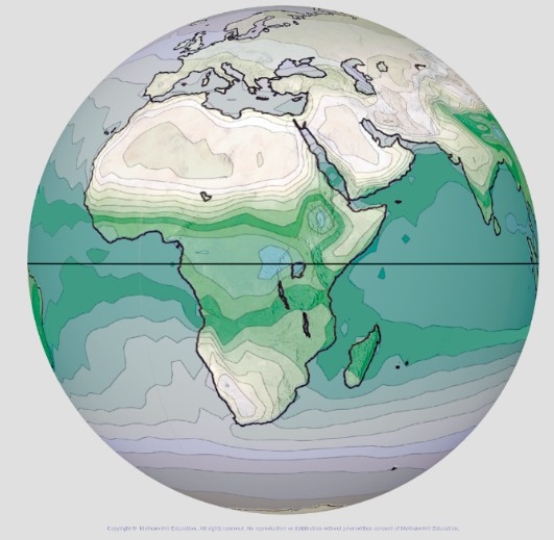
A) The ITCZ shifts position with season
B) The presence of a cold ocean current
C) The westerlies blow from north to south in this area
D) The westerlies blow south to north in this area
Correct Answer

verified
Correct Answer
verified
Multiple Choice
An example of a secondary effect of drought is
A) wildfires.
B) high temperatures.
C) transportation delays.
D) drop in groundwater levels.
Correct Answer

verified
Correct Answer
verified
Multiple Choice
Which of the following environmental lapse rates represent stable inversion conditions? 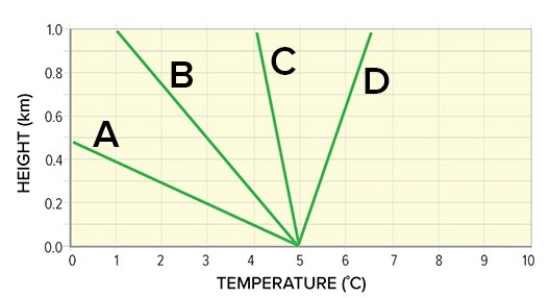
A) A
B) B
C) C
D) D
Correct Answer

verified
Correct Answer
verified
Multiple Choice
Which of the following would most decrease the albedo of a city?
A) Lighter,smoother surfaces
B) Lighter,rougher surfaces
C) Darker,rougher surfaces
D) Darker,smoother surfaces
Correct Answer

verified
Correct Answer
verified
Multiple Choice
In this image from Tibet,water is expressed in a visible form through 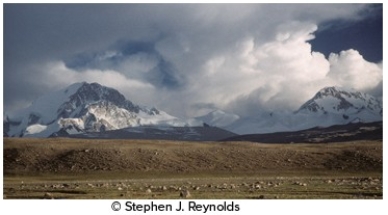
A) water vapor in the atmosphere.
B) clouds suspended in the atmosphere.
C) ice and snow.
D) clouds,ice,and snow.
E) All of the answers here are correct.
Correct Answer

verified
D
Correct Answer
verified
Multiple Choice
Which of the following was NOT discussed in the opening two-page spread of the Atmospheric Moisture chapter?
A) Clouds
B) Precipitation
C) Amount of moisture in the atmosphere
D) Movement of water from the surface to the atmosphere
E) All of these choices are correct
Correct Answer

verified
Correct Answer
verified
Multiple Choice
Which of the following locations would have the lowest specific humidity? 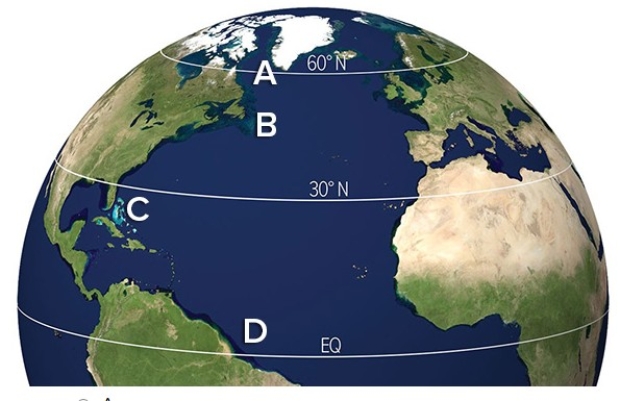
A) A
B) B
C) C
D) D
Correct Answer

verified
A
Correct Answer
verified
Multiple Choice
Which setting would be best suited for creating a fog?
A) High latitude,high humidity,distant to ocean,flat terrain,land breeze
B) Low latitude,high humidity,distant to ocean,flat terrain,sea breeze
C) Low latitude,high humidity,close to ocean,mountains,sea breeze
D) Low latitude,low humidity,close to ocean,mountains,land breeze
Correct Answer

verified
Correct Answer
verified
Multiple Choice
Dew point measures
A) the temperature at which air is saturated with water vapor.
B) a percentage of how close the air is to saturation,how "humid" it feels.
C) the mass of water vapor compared to a total mass of a volume of air.
D) the amount of liquid water droplets in the air.
Correct Answer

verified
Correct Answer
verified
Multiple Choice
This globe from the atmospheric moisture investigation shows specific humidity,with blue and green being highest.What feature most likely coincides with the area of lowest specific humidity? 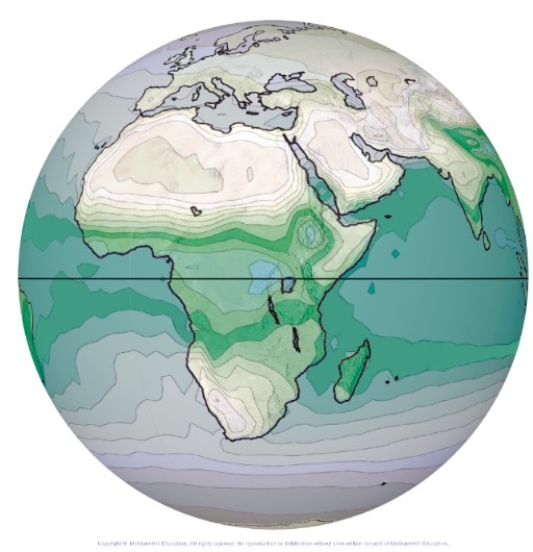
A) The Intertropical Convergence Zone (ITCZ)
B) Dry,descending air in the subtropics
C) The trade winds
D) The cold dry air of the polar easterlies
Correct Answer

verified
Correct Answer
verified
Multiple Choice
In the diagram,there is 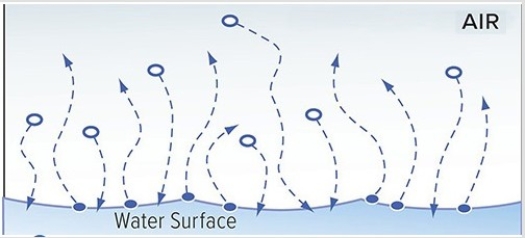
A) higher overall energy levels,with a decrease of water vapor in the air.
B) lower overall energy levels,with an increase of water vapor in the air.
C) an equilibrium between condensation and evaporation.
D) lower overall energy levels,with a decrease of water vapor in the air.
Correct Answer

verified
Correct Answer
verified
Multiple Choice
Which of the following locations would have the lowest specific humidity values in July due to the sinking motion of subtropical high pressure areas? 
A) A
B) B
C) C
D) D
Correct Answer

verified
Correct Answer
verified
Multiple Choice
A parcel of air at 5 km and an initial temperature of 10°C altitude descends to 3 km altitude at the unsaturated adiabatic lapse rate.What is the temperature at 3 km?
A) -30°C
B) 0°C
C) 30°C
D) 60°C
Correct Answer

verified
Correct Answer
verified
Multiple Choice
Convergence resulting in rising atmospheric motion at the surface can occur in all of the following settings except
A) where upper air flow speeds up and there is upper air divergence.
B) where air encounters topographic barriers like mountains.
C) where there is a collision of two wind systems such as found along the equator.
D) where air moves from a large body of land to a large body of water.
Correct Answer

verified
Correct Answer
verified
Multiple Choice
Drought can be caused by all of the following except
A) persistent high pressure.
B) persistent offshore breeze.
C) persistent low pressure.
D) change in the direction of an ocean current.
Correct Answer

verified
Correct Answer
verified
Multiple Choice
Which of the following conditions is best suited to create an advection fog?
A) Vertically descending dry,cold air moving over a warm surface
B) Vertically rising moist,warm air moving over a cold surface
C) Laterally moving dry,cold air moving over a warm surface
D) Laterally moving moist,warm air moving over a cold surface
Correct Answer

verified
Correct Answer
verified
Multiple Choice
For precipitation to occur,
A) the force of gravity is incapable of overcoming the buoyant forces keeping water droplets and ice crystals suspended.
B) instability within the clouds must exceed the pull of gravity.
C) buoyant forces keeping water droplet and ice crystals suspended must be greater than the force of gravity.
D) buoyant forces keeping water droplets and ice crystals suspended must be less than the force of gravity.
Correct Answer

verified
D
Correct Answer
verified
Multiple Choice
A parcel of saturated air at 20°C would have approximately ________ times ________ water vapor than saturated air at 0°C. 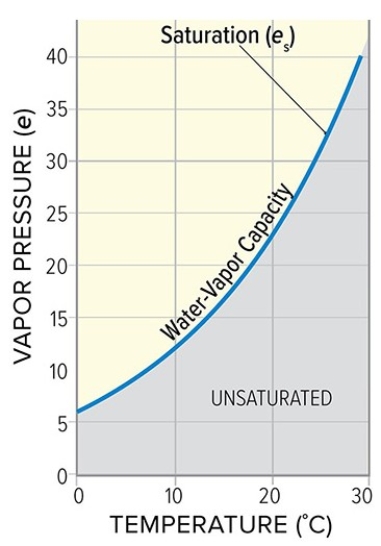
A) 5; more
B) 20; more
C) 5; less
D) 20; less
Correct Answer

verified
Correct Answer
verified
Showing 1 - 20 of 85
Related Exams